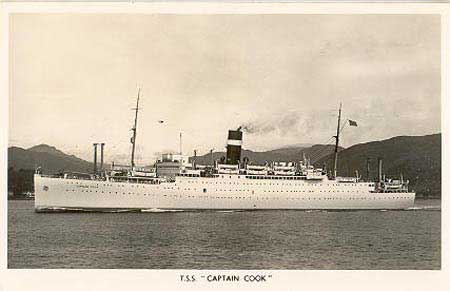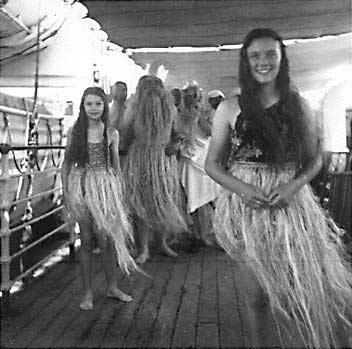|
TSS Letitia, sister ship to ill fated Athenia, had a checkered career
The first LETITIA was a short lived ship. Built by Scott's Shipbuilding and Engineering Co, Greenock for the Donaldson Line of Glasgow, she was a 8,991 gross ton ship, length 470.4ft x beam 56.9ft, one funnel, two masts, twin screw and a speed of 14 knots. There was passenger accommodation for 300-2nd and 950-3rd class. Launched on 21st Feb.1912, she left Glasgow on 4th May 1912 on her maiden voyage to Quebec and Montreal. Employed as a hospital ship during the Great War, she was wrecked on 1st Aug.1917 at Chebucto Head, Halifax, NS with no loss of life. [North Atlantic Seaway by N.R.P.Bonsor, vol.3, p.1014]
Letitia 2 (1925-46) Built as Lelitia 2: 1924, Fairfield, Glasgow. Yard No: 601
She made her maiden voyage from Glasgow to Montreal on April 24, 1925. In 1933 her passenger accommodation was altered to 298-Cabin Class, 310-Tourist Class, 964-3rd Class. In 1935 her owners changed their name to Donaldson Atlantic Line. HMS Letitia (F 16) Armed Merchant Cruiser Royal Navy Type: Armed Merchant Cruiser Pennant: F 16 Built by:Fairfield Shipbuilding & Engineering Co. (Govan, Scotland) Ordered: Laid down: Launched: 14 Oct, 1924 Commissioned: 6 Nov, 1939 End service 7 Jun, 1941. History: On 9 September 1939 the passenger ship Letitia 2 of the Donaldson Brothers Ltd, Glasgow was requisitioned by the Admiralty and converted to an armed merchant cruiser. Conversion was completed on 6 November 1939. Displacement: 13475 BRT Career: On 7 June 1941 returned and used as troopship by the Ministry of War Transport (MoWT). 1944 transferred to Canada and converted to a hospital ship. Patients and Nursing Sisters in ward aboard No. 2 Canadian General Hospital Ship Letitia Liverpool, England, November 24, 1944. She was sold to the British Ministry of Transport in 1946, but was still managed by Donaldson. She was then renamed Empire Brent. On November 20, 1946 she collided with the British steamer Stormont, which sank. She was overhauled and refitted as a troop transport on the Clyde during December 1947. In July 1948 she made her first voyage on troop transport service to India and the Far East. During 1950 she served on Emigrant service from Glasgow to Sydney. During June 1951 refit as an emigrant ship commenced by Barclay, Curle & Co., at Glasgow, which lasted until January 1952. Her third class accommodation was changed to 1,088-3rd Class passengers, and her tonnage was changed to 13,876 GRT. She was then renamed Captain Cook. On February 5, 1952 she made her first voyage from Glasgow to New Zealand. She returned to the Glasgow to Montreal service in April 1955, but after seven round trips she was put back on the New Zealand service again in October 1955. On April 29, 1960 she arrived at Inverkeithing and was broken up by T.W. Ward. In 1951 she was renamed Captain Cook and used on the New Zealand service, still retaining Donaldson as managers. She was scrapped in 1960.
When ships crossed the equator, special celebrations were devised for first-timers ‘crossing the line’. Pictured is Beryl Tuppen (left) dressed as one of Neptune’s daughters, onboard the steamship Captain Cook in 1952. Other passengers dressed up in a variety of characters – Captain Cook, Carmen Miranda and Mae West among others. King Neptune can be also seen in the background directing the proceedings. |




